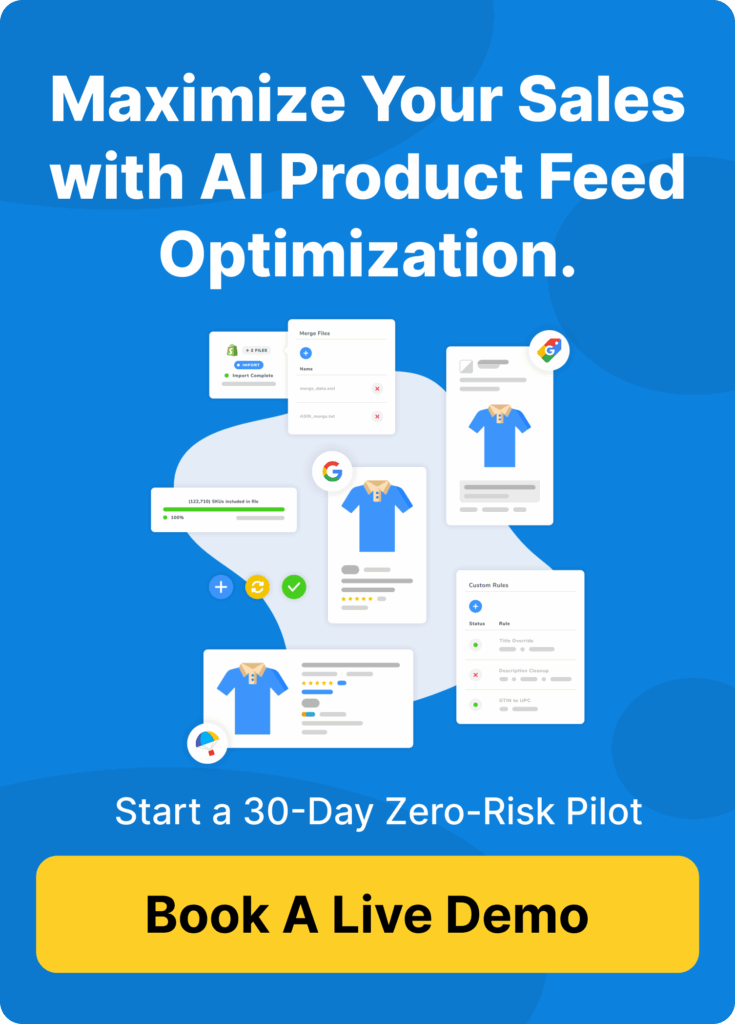Starting your journey in feed optimization can present a few initial challenges. However, these are normal parts of the journey that, once addressed, pave the way for successful and efficient product feed optimization. FeedOps, designed specifically for everyday digital marketers, is a tool that not only helps to overcome these challenges but also streamlines the optimization process.
In this post, we’ll identify two of the most common roadblocks to successful feed optimization and outline how FeedOps assists users in overcoming them. These roadblocks include connecting your e-commerce platform to FeedOps via our API and mapping and cleansing your product data before it’s converted into a product feed for your advertising channels.
Contents
Roadblock 1: Connecting Your Store to FeedOps
A frequent question we receive is – “Why can’t you simply connect to my existing shopping feed or Merchant Center?” Technically, we can. If you’d prefer that we do so, we’ll accommodate your request. However, we don’t generally recommend it. The reason for this recommendation lies in our commitment to providing you with the best outcomes for your product feed optimization.
Connecting FeedOps directly to your e-commerce platform gives us access to your raw product data. This allows for more accurate and comprehensive product feed optimization, translating to better advertising outcomes down the line. On the contrary, connecting to an existing shopping feed or Merchant Center may limit our ability to maximize your product feed’s potential due to the pre-existing data formatting or missing attributes. It also potentially increases the time between when you change a product on your website and when that change shows up in Google, Microsoft and Meta.
Despite the benefits, we understand that establishing the API connection between your e-commerce platform and FeedOps can seem daunting, especially for users utilizing a custom shopping cart. Rest assured, our team has streamlined the process as much as possible. However, if you need a little extra help, don’t hesitate to book a meeting with us. We’re always prepared to guide you through the setup process.
Roadblock 2: Mapping and Cleansing Product Data
It’s crucial to understand that FeedOps never alters the product data on your website. We respect the considerable effort you’ve put into creating a user-focused website. Our focus is on optimizing your product data specifically for its appearance in each of your ad channels.
Once your store is connected, the next critical stage is mapping and cleansing your existing product data before it’s converted into a product feed. This phase is crucial as the quality and structure of your product data directly impacts your advertising outcomes on platforms like Google, Microsoft, and Meta.
Let’s draw a parallel with AI chatbots, such as Bard, Bing Chat, or Chat GPT. The quality and depth of the response you receive from these chatbots depend significantly on the precision, clarity, and completeness of your prompt. A well-structured, comprehensive, and precise prompt will elicit a more accurate, relevant, and comprehensive response. Similarly, in the case of FeedOps, the more precise, clear, and complete your initial product data, the better the AI’s recommendations and enhancements will be.
Much like the way an articulate prompt guides the AI chatbot to provide a meaningful response, meticulously cleansed and mapped product data serves as an effective ‘prompt’ for FeedOps’ AI. It uses this ‘prompt’ to generate detailed and practical recommendations for optimizing your product feed.
FeedOps allows you to optimize the data coming into the platform before it’s converted into a product feed. After this initial optimization, FeedOps enables you to make specific enhancements tailored for each of your advertising channels or groups of channels.
This comprehensive approach allows FeedOps to generate more accurate AI-driven recommendations, thereby accelerating the optimization process and improving your advertising outcomes. We’re essentially fine-tuning your ‘prompt’ for the AI of ad platforms, enabling them to better understand your products. A well-optimized feed then serves as a well-structured ‘prompt’ for ad platforms like Google, Microsoft, and Meta, significantly improving their ability to match your products with potential buyers.
While data mapping and cleansing are optional, these are often overlooked yet crucial steps in feed optimization. Investing in these tasks can create a significant impact on your advertising efficiency and effectiveness. If you’re unsure about how to go about it or if you simply need a hand, we’re here to assist you. Don’t hesitate to contact us or book a meeting for more personalized guidance.
Taking these obstacles head-on is an integral part of your journey towards successful feed optimization. Remember, roadblocks are not dead ends – they’re opportunities to learn, grow, and optimize. So, let’s overcome these common hurdles together, and unlock your full potential in the realm of product feed optimization!



